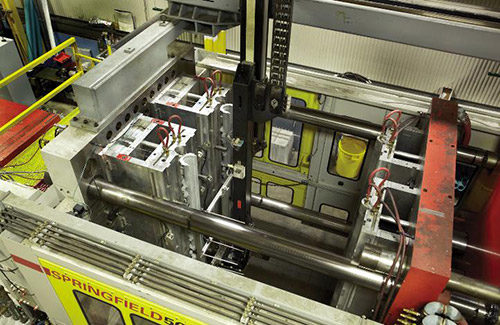Founded in 1953 in Erie, PA, Port Erie Plastics began operations with a single injection molding machine in a small building. Since then, our company has grown significantly to accommodate increasing customer demand. Today, Port Erie Plastics is a leading provider of injection molding services, but, occasionally, another means of processing plastic is a better way to make a part. In recent years, our engineering talent has enabled us to add structural foam molding and extrusion to meet our customers’ needs.
Our Structural Foam Injection Molding Capabilities

Our structural foam injection molding equipment allows us to produce parts up to 7.5 feet in length with a typical wall thickness range of .200 to .500 inches. Our low-pressure structural foam machines have platen sizes of 98 inches x 89 inches and tie bar spacing of 58.5 inches x 67.5 inches. The shot size is up to 150 lbs. The structural foam process allows for running more than one mold at the same time in a single machine. We are happy to quote any new or existing structural foam projects.
We typically process the following materials in these machines:
- Polyethylene (PE) foam is a durable and lightweight closed-cell material. It offers excellent load-bearing, shock absorption, and vibration dampening properties as well as resistance to chemicals, grease, moisture, and solvent.
- Polypropylene (PP) is a rigid and lightweight closed-cell material. It offers excellent compression and impact resistance as well as resistance to chemicals and moisture across a broad temperature range.
Case Study: Process Redesign of Structural Foam Molded Trench Drains
Equipped with over 60 years of injection molding experience, we have the knowledge and skills to create structural foam components for virtually any customer need. This expertise also allows us to help customers optimize existing structural foam molding processes to achieve better product and production quality.
In one instance, a customer in the construction industry came to us to redesign their existing structural foam molding process. They were using a straight injection molding process to manufacture a line of linear trench drains for use in industrial, commercial, and residential applications. However, the single-cavity molds utilized in the existing process resulted in long cycle times and produced parts with warping and low dimensional tolerances.
Our team redesigned the manufacturing process to use the low-pressure structural foam molding method, which resulted in a 20% part weight reduction and a 40% cycle time reduction over the original process. The new process allowed for the creation of trenches in 17 different sizes. We built the aluminum molds and designed tools with interchangeable molds to allow the customer to run any two of the 17 sizes in a single machine at the same time.
For more information on this project, check out the full case study.
Advantages & Benefits of Structural Foam and Extrusion
Structural foam molding is an injection molding process that involves injecting liquid resin with an inert gas or a chemical blowing agent. The mixture is then injected into the mold cavity, where the gas or blowing agent expands and forces the resin to fill all areas of the cavity. As the material comes into contact with the walls of the mold, the surface cells collapse, resulting in a smooth and solid surface on the outside of the molded component.
Compared to other manufacturing methods, the structural foam injection molding process offers a number of advantages, such as:
- Excellent moldability. Structural foam is highly amenable to molding. It can be used to create parts with walls and other elements in various thicknesses without risk of warping or deformation due to stress experienced during the molding process.
- High strength-to-weight ratio. Structural foam components are generally very lightweight (typically ranging from 2 lbs/ft3 to 55 lbs/ft3). However, they are also strong, durable, and rigid.
- Great thermal stability. Structural foam exhibits little to no thermal expansion, which makes it ideal for products used in a wide range of temperature conditions.
- Good acoustic and thermal insulation properties. The nature of the material makes it perfect for use in products that require acoustic or thermal insulation.
- Exceptional cost-effectiveness. The structural foam molding process utilizes lower clamping forces and pressures than other molding methods, which allows it to use less durable tools made from less expensive materials (e.g., aluminum).
Partner with Port Erie Plastics
If you need a partner for your structural foam molding and extrusion project, turn to the experts at Port Erie Plastics. To learn more about our capabilities, check out our case studies or contact us today. To discuss your project requirements with one of our team members, request a quote.
Case Studies
- Quick Turnover of Production & Tool Transfer
- Development of Custom Molded Polymer Fittings for the Plumbing Industry
- Process Redesign of a Structural Foam Molded HDPE Trench Drain for the Construction Industry
- Injection Molding of Custom Polypropylene and Elastomer Lids for the Cookware Industry
- Development of Safe Combination Dial for the Safe Manufacturing Industry


